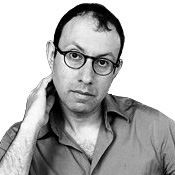The still photographer on a movie set must be nearly invisible—stealthily alert to the moment that will distill time, like a sonogram of the movie taking shape. There are few virtuosos of the form.
Alfonso Avincola is one of them. A treasure of Italian cinema who is revered in America, Avincola is now 91 and living in Los Angeles. I invited him and his daughter, Federica Carrion, to Dan Tana’s, on Santa Monica Boulevard, last fall. He had never been, and Carrion said he was curious about the place. Wearing a leather jacket, he entered the crowded, noisy restaurant with a sure step. A shy man of delicate features, Avincola has a thatch of gray hair that hangs over his forehead, giving him an almost mischievous look.
Once we were settled into a red leather banquette, Federica, who translated most of our talk, recognized the actor Jon Hamm sitting at one of the larger tables. Avincola wasn’t particularly impressed. After all, he had sipped espressos with Marcello Mastroianni and broken breadsticks with Pier Paolo Pasolini. He’d stood behind Vittorio De Sica and had gazed darkly through a lens at Monica Vitti, Claudia Cardinale, and Charlotte Rampling. He was the third person in bed, off-camera, with Robert Redford and Faye Dunaway, photographing their love scene in Sydney Pollack’s Three Days of the Condor.
Born in 1931, Avincola’s most vivid memory is of the Second World War and the arrival of American troops in Rome. He recalls the long lines of trucks on the Via del Vaticano headed north, “the kids waving to the columns of American soldiers who would throw packs of candy with holes in the middle—Life Savers.”
After finishing high school, Avincola worked as an office boy, delivering photos to the Italian papers. Before long, he found himself covering crime, politics, and entertainment. Toward the end of the 1950s, he made his move to the photojournalist Pierluigi Praturlon’s studio, and he began visiting movie sets, including that of the 1959 epic Ben-Hur, starring Charlton Heston.
Enter Dino de Laurentiis, the larger-than-life producer (along with Carlo Ponti) of Federico Fellini’s La Strada and Nights of Cabiria. Though his business would ultimately falter in the 1970s, de Laurentiis was behind a staggering number of popular movies: Serpico, Death Wish, The Shootist, Ragtime, Manhunter, and a handful of Stephen King adaptations.
De Laurentiis took Avincola under his wing, making him the family’s personal photographer. “De Laurentiis was de Laurentiis,” Avincola recalls. “It was hard to tell him no. I remember he had this habit of bringing his fists down on his enormous desk—he must’ve bought it from the Vatican. He would do it even when he wasn’t angry!”
He had sipped espressos with Marcello Mastroianni and broken breadsticks with Pier Paolo Pasolini.
When Avincola first arrived at de Laurentiis’s office, the producer “slammed my photos on his desk and said, ‘What the hell are these? You can’t see anything!’ Luckily, the film’s cinematographer was there in the office and said, ‘Look, these photos are identical to what you see on the screen.’ I was hired.”
Also working for de Laurentiis was an assistant named Liliana Matthews, who later became chief operating officer of De Laurentiis Entertainment Group in America. Avincola and Matthews began dating, and were married for nearly 60 years, until her death, from the coronavirus, in 2020. “There was a rumor going around that I worked with Dino because I was married to his personal assistant,” Avincola confides, “but when I started collaborating with de Laurentiis, I wasn’t married, and I didn’t even know Liliana.”
Avincola became close to de Laurentiis’s wife, the magnificent Italian actress Silvana Mangano, who had risen from the neo-realist movement to become a cinematic star working with directors such as Pasolini, De Sica, and Luchino Visconti. Her career lasted well into the 1980s and included an appearance in David Lynch’s Dune.

Of Mangano, Avincola says, “On set we would joke and laugh, but then Dino would show up, and she would say, ‘Let’s pretend to be serious. The producer is arriving.’” His photos capture the warmth and intelligence of her face.
Of Mastroianni: “He was always calm. I remember when Visconti would make him re-shoot scenes just for the stills, in the tremendous heat of Algeria.”
Vitti’s first encounter with Avincola almost didn’t happen because she had canceled so many photo shoots. Avincola finally sent a message to her secretary, saying, “When Vitti is up for it, call me.” She did, and after the first few clicks, Avincola recalls, Vitti theatrically declared, “‘I want you to be my photographer on all my future films!’ And so it was.”
Among his unforgettable stills: Jane Fonda as Barbarella in the 1968 movie of that name, staring straight at you with tousled hair and over-the-knee, dazzlingly white leather boots; Redford and Dunaway lying together in Three Days of the Condor (1975), a double portrait of tristesse; from the set of Orca (1977), a brutish and harnessed Richard Harris and a sullenly seductive Rampling; Cardinale with a Mona Lisa smile in Il Magnifico Cornuto (The Magnificent Cuckold), in 1964.
Toward the end of our evening together, I asked Avincola if I could take his picture—alas, with my phone. I could tell he was all too used to a world swarming with such photographers taking aerial pictures of their cheeseburgers. But unable to resist, I pointed my phone at him, as he raised his glass, and took the photo. When I showed it to him, he said, “It’s not bad, but it’s not the same. New world.” He sighed, the ghost of a smile crossing his face.
Sam Kashner is a Writer at Large at AIR MAIL. Previously a contributing editor at Vanity Fair, he is the author or co-author of several books, including Sinatraland: A Novel, When I Was Cool: My Life at the Jack Kerouac School, and Life Isn’t Everything: Mike Nichols, as Remembered by 150 of His Closest Friends







